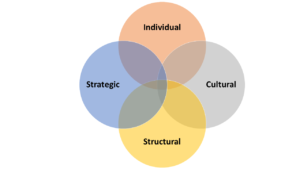In my last post, How Healthy is Your Board?, I discussed the four domains that drive how board members show up and contribute given the cultural, structural, individual and strategic orientation of an association.
If your goal is to help your board move from one that is dysfunctional (think member conflict or disengagement) to transformational, you need to first step back and look at it holistically. This allows you to spot all the indicators in each of the four domains that are contributing to your board’s dysfunction.
The four domains of board functioning include:
- Individual
- Cultural
- Structural, and
- Strategic
 The four-domain framework essentially provides a balanced scorecard approach to board evaluation. Although the domains are presented as four discrete areas, in reality, they aren’t. They might be more appropriately represented as a Venn diagram or matrix; they’re interwoven. The usefulness of separating them into separate domains is in diagnosing the root cause of suboptimal functioning.
The four-domain framework essentially provides a balanced scorecard approach to board evaluation. Although the domains are presented as four discrete areas, in reality, they aren’t. They might be more appropriately represented as a Venn diagram or matrix; they’re interwoven. The usefulness of separating them into separate domains is in diagnosing the root cause of suboptimal functioning.
In each of the four domains, there are inhibitors and enhancers to effective board functioning. Let’s take a closer look at each of the four domains, what health in that domain looks like, and some examples of key ailments.
In a more acute phase of the disease, board members engage in fights (verbal – or worse, physical), board members and staff start quitting, and the board begins striving for mediocrity…
Cultural
In the Cultural domain, signs of board health include:
- Decisiveness: The board is effective at thoughtful deliberation, engaging in productive dialog, then arriving at a consensus decision – quickly.
- Deliberation: The board does its homework. Decisions are made based on data vs. opinions and made only after thoughtfully examining the issue.
- Engagement: Discussions are balanced, not dominated by a few outspoken individuals while others remain passively disengaged. Board members really show up, not just physically, but mentally and emotionally.
- Unity: Even if there is dissent during deliberations, board members are not only able to unite behind the ultimate outcome, but be an advocate for it. When heated discussions occur, board members attack the issues but not each other.
- Trust: Regardless of where people stand on the issues, they ultimately trust that everyone has the best interest of the organization in mind. Board members assume positive motives among their peers and have each other’s backs. The board is able to delegate authority and responsibility to staff and committees without second-guessing or micromanaging.
A key example of a Cultural domain ailment is Factionitis/Divided Board Syndrome. The chronic symptoms of this disease are a total inability to govern, a loss of organizational focus, and board members dreading attending the meetings. Boards members might say to themselves, “If we could just have one board meeting without an ugly fight, that would be awesome!” Key signs the disease has become a critical illness are when Lawyers, accountants, and/or PR firms (to do damage control) are hired. Other signs of critical illness are member fights, an election coup d’état, or the formation of splinter organizations.
Individual
In the Individual domain, signs of a healthy board member include:
- Loyalty: I support board decisions even when I was dissenting vote. I disclose any conflicts of interest I have.
- Accountability: I follow up and follow through on my commitments. I hold others accountable to board norms, governing documents, and decisions.
- Altruism: I’m in it for the best interest of the organization and its mission first, not my personal agenda.
- Collegiality: I agree to disagree without being disagreeable. I’m a team player.
- Integrity: I do what’s right. I do what I say I’ll do when I say I’ll do it.
A common example of an Individual ailment is a Bully Infection. Chronic symptoms are a fight or flight reaction every time the board bully shows up and uncontrollable eye-rolling after everything they say. The disease is more acute when board members engage in reactionary behavior, such as flame emails and pre-emptive attacks, resulting in derailed meetings.
Structural
Some signs the board is Structurally healthy include:
- Guidelines: In addition to basic governing documents such as the bylaws, the board has a policy manual that clearly delineates roles and responsibilities for the board, CEO/Staff and committees.
- Composition: The board is the right size for effective decision-making and is balanced and diverse in its representation of stakeholders.
- Training: Board members receive a thorough onboarding and ongoing development.
- Selection: Board members are carefully selected based on competencies, skillsets, mindsets and the organization’s strategic direction. There is a formal process for identifying, recruiting, and qualifying new board members.
- Succession: The board has a written succession plan in place and a leadership development system to assure adequate leadership bench strength.
Bloated Governance structures are an example of a Structural ailment. Chronic symptoms of a bloated governance structure include “filling seats” in a complex org chart rather than seeking the most qualified individuals, and an inordinate amount of time and resources (staff support, board meeting expenses) invested in feeding the structure. The illness is acute when the organization is unable to respond to crises and even the most mundane of decisions require months (maybe years) to make. The disease becomes critical when the external environment requires change, but the organization incapable of adapting.
People problems can only be solved through human interaction and constructive dialog, not through policies and procedures alone.
Strategic
Following are some indicators the board is healthy in the Strategic domain:
- Direction: The staff and/or committees execute a clear business plan in support of the board’s strategic direction.
- Focus: The board uses the mission, vision and strategic plan as its guideposts for decision-making. The strategic focus areas are included on every board meeting agenda.
- Foresight: The board sets aside time on a regular basis to scan the horizon, monitor emerging issues, and adjust to anticipated changes.
- Innovation: The board is willing to take calculated risks and try out new ideas.
- Mindset: The board has big picture thinkers, discussions stay high level most of the time and are rarely inwardly focused on operational
Getting “Ubered” Syndrome is an example of a strategic malady. The chronic symptoms include heads stuck in the sand and an inability to see the signs of change. The disease becomes acute when the board tries to catch up when it’s already too late. Ultimately, the disease may prove fatal to the organization.
Is removing barriers to your Board of Directors’ effectiveness a 2019 priority for your organization? If so, contact us for our complimentary Board Health Test to identifying the underlying issues for your board.
About the Author
 Jeff Arnold, MAM, CAE, is CEO of Leading Associations which supports professional associations by bringing a full spectrum of board, management and operational solutions that help them work through challenges that inhibit progress, and grow membership.
Jeff Arnold, MAM, CAE, is CEO of Leading Associations which supports professional associations by bringing a full spectrum of board, management and operational solutions that help them work through challenges that inhibit progress, and grow membership.
Jeff brings a combination of association experience and formal education to Leading Associations’ clients. His present responsibilities include dealing with both the strategic and tactical aspects of running associations. His special areas of expertise include working with boards and committees, certification, training programs, and membership systems. You can reach Jeff on LinkedIn or via email.

